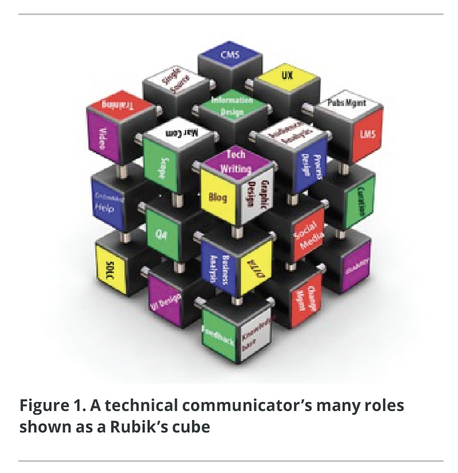By Dr. Jackie Damrau | STC Fellow
Strategic thinking is not simple. It requires research, planning, preparation, and communication to ensure that all employees are aligned to achieve that strategy.
Strategic thinking and strategic plans exist in every business from the smallest to the largest. Even freelancers and self-employed must be strategic thinkers and have a strategy plan to be successful. Unless, of course, you’ve found the pot of gold at the end of the rainbow!
This article will give a brief glimpse into strategic thinking within technical communication and then shows different strategic models used in knowledge management and business process management.
Strategic Thinking within Technical Communication
Giordano1 authored an informative article about “Integrated Technical Communications: A Strategy for Technical Communicators” for TechWhirl. She related the concept of Integrated Technical Communication (ITC) and the work that a technical communicator goes through to that of a Rubik’s cube (Figure 1).
 Strategic thinking within the technical communication (TC) arena requires a mindset change as we, the technical communicators, become the key players in communications programs and other business areas within our companies. Giordano states, “Twenty years ago . . . we were the makers and keeps of procedural documentation . . . These days our jobs are far more complex . . . our actions involve us in developing and influencing a great of customer interactions.” She describes the five key drivers for why complexity has entered the TC world:
Strategic thinking within the technical communication (TC) arena requires a mindset change as we, the technical communicators, become the key players in communications programs and other business areas within our companies. Giordano states, “Twenty years ago . . . we were the makers and keeps of procedural documentation . . . These days our jobs are far more complex . . . our actions involve us in developing and influencing a great of customer interactions.” She describes the five key drivers for why complexity has entered the TC world:
- “Users have high expectations for products and are willing to share their (dis)pleasure publicly through social media outlets.
- Extensive and often far-flung project teams are planning and deploying more complex and integrated products and services.
- Outlets for user support are more diverse due to the rise of social media and new customer relationship approaches such as user-generated content.
- Businesses push to be ever more productive with fewer staff and resources, so the professionals in these companies are pressed into service on more fronts than ever before.
- Our employers are discovering that we understand the customers — both internal and external — very, very well.”
Giordano then says that we need to step up and ask strategic questions like:
- “Why should we enter this market?”
- “Why do we want to compete here?”
- “Why do our competitors want to be in this market?”
The answers should lead us to the “how” questions on development, pricing, distribution, and messaging. Which lead to devising the tactical solutions to meet with the strategy.
Giordano then talks about the integrated technical communication (ITC) approach. Her definition, “ITC is the coordination and integration of all technical communication processes, tools, functions, and sources within an organization to convey information and knowledge relevant to optimizing the users’ product experience.” The main principles behind ITC are:
- Focusing on increasing the users’ understanding and experience.
- Emphasizing more on integration rather than processes, tools, and functions.
In using ITC, this leaves more room to look “for strategic coherence in our visioning, planning, and execution” of TC activities.
Business process management comes with its own prescribed strategic thinking models and philosophy. Its relationship to technical communication is that one must know the business processes to understand the technical vision to deliver the overall business strategy.
Business Process Management Requires Strategic Thinking
Business process management (BPM) uses a separate set of models and perspectives for companies when building their strategic plan. Franz & Kirchmer say, “Strategic importance refers to any process that requires a high degree of knowledge intensity and has a high customer impact. These processes are important to an organization’s long-term business strategy.”2 When developing a BPM strategy, their suggestion is:
- Build a process strategy that “defines general aspects of a process, including ownership, definition of KPIs, and a framework for measuring how well it is working.”
- Use process analysis to “find the most significant opportunities for improvement” based on your roadmap goals.
- Determine through process design how to change the process to meet the improvement objectives.
- Implement and execute the process to watch and monitor the effects or the actual changes to the process improvements and determine to keep or reject them.
Harmon outlines the interactions a company should consider when building their strategy (Figure 2):3
 When looking at Harmon’s model, consider this quote from DAMA International:4
When looking at Harmon’s model, consider this quote from DAMA International:4
“A strategy is a set of choices and decisions that together chart a high-level course of action to achieve high-level goals. In the game of chess, a strategy is a sequenced set of moves to win by checkmate or to survive by stalemate. A strategic plan is a high-level course of action to achieve high-level goals.”
Orion Development Group states, “Process improvements will not translate into better business results if they do not generate strategic value. That is why the Association for Business Process Management Professionals (ABPMP) made ‘Alignment to Strategy and Goals’ the first step in its new BPM Life Cycle” (Figure 3).5
 Orion Development builds on Harmon’s model by agreeing that aligning the business to its strategy and goals is important as the first step. The other phases in the Orion model then follow to help build a strong strategic plan. They further feel that strategic planning and BPM are a two-way relationship where “processes must execute strategy [and] also shape strategy by creating new capabilities and customer value.” Companies need to excel at both elements of the strategy-process relationship.
Orion Development builds on Harmon’s model by agreeing that aligning the business to its strategy and goals is important as the first step. The other phases in the Orion model then follow to help build a strong strategic plan. They further feel that strategic planning and BPM are a two-way relationship where “processes must execute strategy [and] also shape strategy by creating new capabilities and customer value.” Companies need to excel at both elements of the strategy-process relationship.
Models are great, yet leadership also needs to be aware of what it takes to look throughout the company for ways of innovating, changing, and building on the great practices already in place and then furthering those practices with new additions. Dr. Al Vicere, Vicere Associates Inc. and the Pennsylvania State University, created the Strategic Leadership Model6 that “demonstrates how leaders can implement strategic thinking into their leader profile.” This model consists of:
- Looking Out at social, demographic, economic, business, and the societal trends that are causing an issue to arise
- Looking Around at competitors, potential competitors, or other benchmark companies that may be seeing the same issue
- Looking in the Mirror to determine what the leadership needs to do to understand the decision, the issue, and make a strategic decision to move forward
- Looking to the Team by communicating to the team the reason for the decision, what it means, and how they can help
- Looking for Results by continually re-engaging the first four steps of the model to continue moving the company forward
The best BPM strategic thinking advice comes from Roger Tregear, a renowned BPM export, who lists the five steps for devising a BPM strategy:7
- Strategy: Deliver value to customers and other stakeholders.
- Process: Done through a series of coordinated activities across functional elements of the company.
- Process Improvement: Optimize processes so they satisfy customer and stakeholder requirements.
- Process Management: Develop a performance-coordinated view of the processes by which a company adds value and optimizes performance.
- Execution: Focus on processes that create differentiation in the market described by the strategy.
We’ve talked about strategic thinking in international technical communication, knowledge management and business process modeling. What strategic thinking strategies can you bring to the table to help your team, department, or company meet their overall objectives?
Conclusion
You can see that strategic thinking is not simple. It requires more research to consider internal and external challenges/pressures; views of the competition and how they measure up; review of your own processes for continuing, replacing, or eliminating; and building a plan that everyone can get behind. Everyone in this context is not just the company executives; it does need to be shared company-wide so that all employees understand where the company has been, where it wants to go, and that they are a part of the company journey to achieve that strategy.
This article gave a brief glimpse into strategic thinking within technical communication. I’m interested in hearing how you incorporate strategic thinking or what strategic models you use in the knowledge management and business process management areas.
References
- Giordano, Connie. n.d. “Integrated Technical Communications: A Strategy for Technical Communicators.” TechWhirl. https://techwhirl.com/integrated-technical-communications-strategy-for-technical-communicators/
- Franz, Peter, and Mathias Kirchmer. 2012. Value-Driven Business Process Management. New York: McGraw-Hill.
- Harmon, Paul. 2007. Business Process Change: A Guide for Business Managers and BPM and Six Sigma Professionals. 2nd ed. Morgan Kaufmann Publishers.
- DAMA International. 2017. DAMA – DMBOK Data Management Body of Knowledge. 2nd ed. Technics Publications.
- Orion Development Group. n.d. “Aligning BPM to Strategy & Goals: How to Maximize the Impact of Process Improvement – A One-Day Seminar.” https://businessprocessmgmt.com/aligning-bpm-to-strategy-goals
- Athena Online, “Strategic Leadership with Dr. Al Vicere,” YouTube Video, 3:39. 1 August 2010. https://www.youtube.com/watch?v=6y9rKebJOtY
- Veyrat, Pierre. 2016. “BPM Strategy and the Concept of Process Management.” Heflo. https://www.heflo.com/blog/bpm/bpm-strategy
 Jackie Damrau (jdamrau3@gmail.com) is a Fellow of STC and the Book Review Editor of the Technical Communication journal. She is senior business analyst with Cathedral Plumbing in Carrollton, TX, working on the MiView IS product.
Jackie Damrau (jdamrau3@gmail.com) is a Fellow of STC and the Book Review Editor of the Technical Communication journal. She is senior business analyst with Cathedral Plumbing in Carrollton, TX, working on the MiView IS product.


